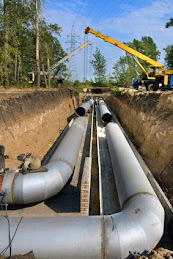Sometimes a pipe is in such bad condition that modern sewer pipe lining is not possible. Examples would be when extensive sections of the pipe are partially collapsed which is common for Orangeburg pipe, or large sections of pipe are missing which is common for cast iron pipe, or a customer is unfamiliar with pipe re-lining, which is the more modern method used in trenchless pipe rehabilitation. In such cases pipe bursting technology is used.
The pipe bursting technology involves pulling a cone-shaped "head", with a new high density polyethylene (HDPE) pipe attached, through an existing pipeline. As the head moves through, it breaks the old pipe and pushes the pieces back into the surrounding soil. The head also expands the bore diameter slightly larger than the outside diameter of the new pipe it is pulling in. This reduces friction, but it also makes it possible to replace an existing pipeline with one of a larger diameter. Of course very powerful winches and strong cables have to be used for this type of sewer pipe rehabilitation.
A bursting head with no other attachment is called a static head, and it depends entirely upon the power of a winch to pull it through an existing pipeline. In some cases, a bursting head is equipped with a cutting blade or an internal pneumatic hammer. The cutting blade concentrates all the pulling force into one area, making the initial opening of the pipe easier. In hard, dry soils, or when heavy pipe fittings are encountered, the driving force of a hammer aids penetration.
Subscribe to:
Post Comments (Atom)

No comments:
Post a Comment